Search Results
BART is doing its part to keep creeks clean with low-impact development at Lafayette Station
Above, example of a "rain garden" that helps absort runoff and filter out pollutants from the water By MELISSA JORDANBART Senior Web ProducerTake a moment to look, listen, and smell the natural environment of the new, low-impact development at Lafayette Station – it’s a window into what’s possible when
One Book One BART returns with a natural history theme, new book, and 3 outdoorsy events

Click here to sign up for the One Book One BART mailing list.
Just in time for National Reading Month, BART is thrilled to announce the One Book One BART Spring 2025 book club, this time with a natural history-themed group read and three events for nature lovers of all ages and interests (scroll down to “Events” for more info).
BART's book club is novel strategy for rider and employee engagement that invites members of the public to read the same book at the same time and participate in themed events in BART trains and stations.
As BART faces a significant financial crisis, we are experimenting with new and creative ways to engage community members and get people riding – and excited about – BART. One Book One BART encourages people to get on BART and experience the region’s abundance of transit-accessible adventures, all while celebrating the long tradition of reading books onboard.
"The BART book club's natural history theme is an inspiration to get out and explore the remarkable place in which we live," said BART Board President Mark Foley. “BART can transport you to so many green spaces, from the urban wilds of Lake Merritt to the mudflats of Point Isabel, and it takes you there in earth-friendly style.”

This year’s official One Book One BART selection is Bay Area Wildlife: An Irreverent Guide by local conservationist Jeff Miller, with illustrations by Oakland-based artist/author/conservationist Obi Kaufmann. Bay Area Wildlife, which is published by Berkeley-based nonprofit Heyday Books, takes an educational and highly entertaining approach to the region’s local fauna, “revealing why each of these creatures matters, as well as the threats that loom over our region’s incredible biodiversity.”
"How cool that Bay Area Wildlife is the selection for this year’s BART book club, connecting Bay Area residents with our open spaces and wildlife neighbors," said author Jeff Miller. "When you get outdoors to explore, definitely ditch the car and use public transit for your Bay Area wildlife expeditions. Our car-centric culture results in a disturbing toll of road-killed animals, fragmentation of wildlife habitat, and spewed emissions that are altering the climate to the point of impending species extinctions. How we move through the world also affects us and how we perceive our surroundings. Riding BART is a great way to do yourself and the planet a favor while connecting with our amazing bioregion."
Added Gayle Wattawa, general manager and editorial director at Heyday Books: “Heyday is thrilled to partner with BART on this innovative book club. One of the many reasons we take BART is that we get to read on board! And we get to feel good about the environmental impact. So why not pick up this funny Bay Area nature guide published by a local nonprofit publisher at a BARTable independent bookstore (yay, you!), admire Obi Kaufmann's beautiful artwork, read it—and laugh out loud—onboard, and exit the station more deeply attuned to our beautiful natural setting? All the wins.”
Bay Area Wildlife will serve as a jumping off point for a series of free outdoor excursions by BART stations and on trains – just pay your fare! The events are intended to encourage the public to take BART to explore and witness the Bay Area’s wealth of natural phenomena. Public transportation is one of the greenest ways to get around, and the many at-risk wildlife populations who call the Bay Area home are yet another reason to prioritize sustainability when you travel. Focusing on nature is also a key theme of Earth Week, which is celebrated globally during the week leading up to April 22. BART is committed to raising awareness about environmental issues and ways that BART riders can do their part to protect our planet.
“This year’s One Book One BART book club emphasizes that our transit network connects us to places and people, flora and fauna,” said BART Communications’ Michelle Robertson, Principal Marketing Rep., who created One Book One BART. “BART provides access to so much more than urban centers – did you know there are 900 parks located within a mile of our stations? It’s true! So pick up a copy of Bay Area Wildlife, hop onboard a train, and explore the majestic natural world that surrounds us – that includes gazing out of the big windows onboard our trains. You never know what natural wonders you’ll discover!”
Bay Area Wildlife illustrator Obi Kaufmann also created three original paintings that feature wildlife found by BART. The works will soon be displayed in ad spaces across the BART system.
Get going on your next outdoor adventure, by visiting bartable.bart.gov/outdoors to discover a wealth of hikes, bike rides, and outdoor itineraries by BART stations. And check out the many libraries accessible by BART.
One Book One BART homepage: bart.gov/bookclub
Download the One Book One BART flyer to print and post here [pdf]
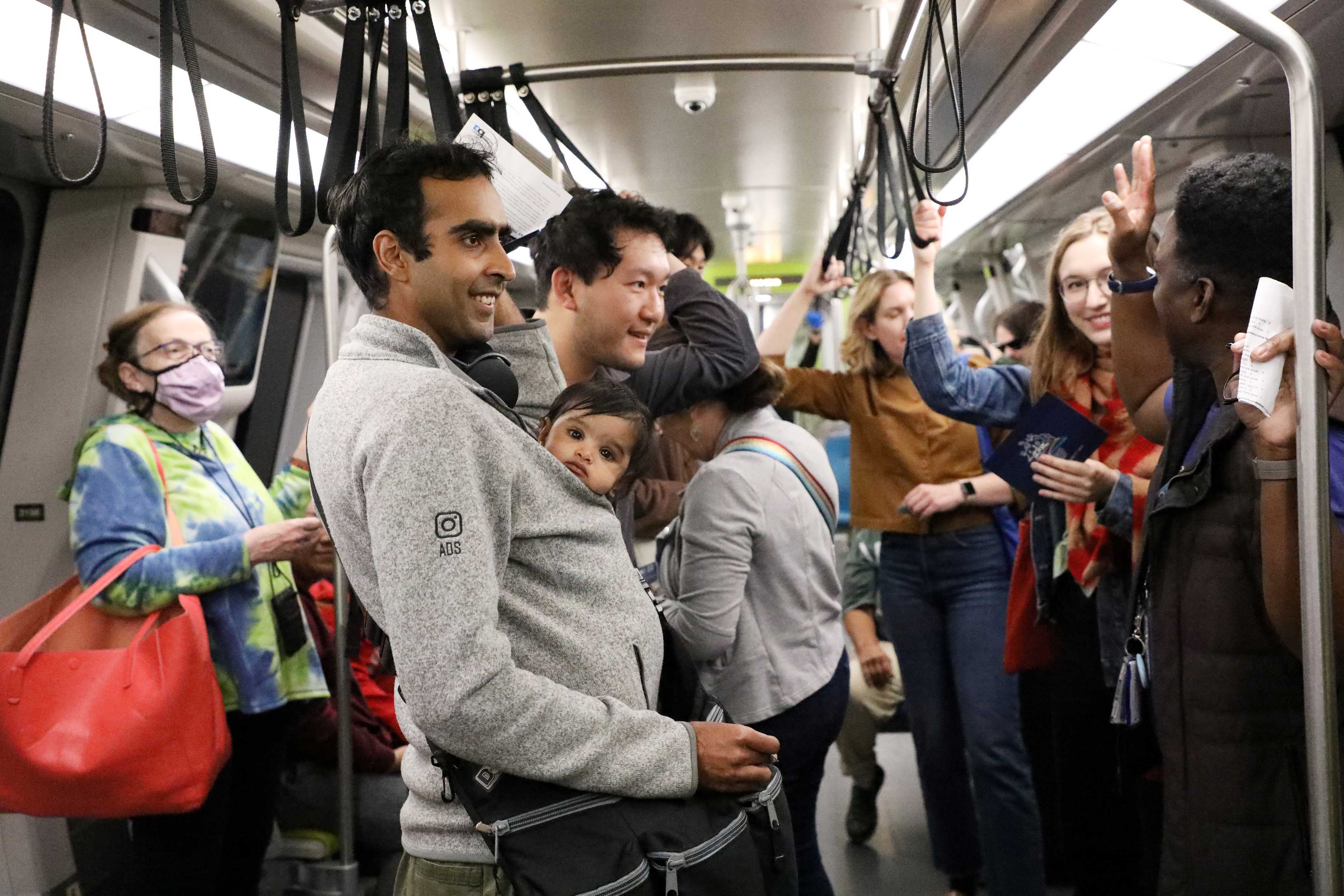
A photo from One Book One BART’s 2022 ”train read-in,” a book club on a moving, in-service train.
One Book One BART Events
All events are free to attend. Just pay your BART fare!
Guided Nature Walk with Author Jeff Miller and Pals
When: Saturday, April 19
The first walk will leave the station at 9am. The walk from 19th to Lakeside Park will take approx. 45 - 60 minutes. RSVP for the first walk (9am) on Eventbrite here
The second walk will leave the station at 11am. The walk from 19th St. to Lakeside Park will take approx. 45 - 60 minutes. RSVP for the second walk (11am) on Eventbrite here
Where: 19th St/Oakland Station to the Rotary Nature Center
Itinerary subject to change.
Meet Bay Area Wildlife author Jeff Miller as he and some conservationist colleagues and local naturalists take us on a ~1.4-mile guided nature walk of Lake Merritt that will begin at 19th St. Station in Downtown Oakland.
Expect to see lots of water birds and an assortment of herons and egrets, maybe even some fish! The walk will end in the grassy area adjacent to the Rotary Nature Center on the lake, where participants will have the opportunity to rendezvous with and learn from local environmental organizations.
Wear comfy walking shoes, fill up your water bottle, and bring whatever else you may need for the walk. And don’t forget your copy of Bay Area Wildlife – Jeff will be signing books.
Bike Ride and Birdwatching
When: Saturday, April 26
- Early short ride - Departs North Berkeley Station at 7:45am. The ride is approx. 8 miles roundtrip and will end at North Berkeley Station at approx. 9:45am. RSVP for the 7:45am short ride on Eventbrite.
- Long late ride - Departs North Berkeley Station at 10am. The ride is approx. 15 miles roundtrip and will end back at North Berkeley at approx. 1pm. RSVP for the 10am long ride on Eventbrite
Where: North Berkeley Station
Itinerary subject to change.
Heath Maddox, BART Manager of Bicycle and Micromobility Access Programs, and local birdwatchers will host two bike rides -- a shorter one for early birds and a later one for those looking for a long ride -- with birdwatching stops along the way. The ride will start and end at North Berkeley Station.
In addition to the expertise of local birdwatchers, we’ll have a digital guide featuring info on birds we might spot on the ride. Find the short 7:45am route here and the long 10am route here.
Bring your bike, helmet, and binoculars – we’ll have extras on hand to lend. You should also bring anything you need to be self-sufficient and keep your bike rolling (spare tube, patch kit, pump, etc.). If you do not have a bike, you can rent one from the Bay Wheels hub at North Berkeley Station.
BART Train Expedition with Obi Kaufmann
When: Saturday, May 3, noon to approx. 1pm
Where: Pleasant Hill/City Centre Station to 12th St/Oakland Station
"Bay Area Wildlife" illustrator and acclaimed poet-naturalist Obi Kaufmann takes the public on a first-of-its-kind BART Train Expedition! The free, family-friendly ride on an in-service passenger train will take us on a journey through the East Bay’s mosaicked, ecological landscape – all through the windows of a Yellow Line train. During the ride, Kaufmann will transport us through “deep time” as he tells stories about the area’s ecosystems, water, fire, infrastructure, volcanic history, trees, and more.
At the end of the approx. 30-minute ride, we’ll disembark at 12th St./Oakland Station and walk with Obi to Frank Ogawa Plaza, where we’ll pay homage to the Town’s most famous oak tree.

A photo from BART HQ Book Day 2023, a celebration of books and community held for employees at BART HQ.
Where to find the book
Bay Area Wildlife is available for purchase at many local bookstores, including our One Book One BART independent bookstore partners, who are offering 20% off the title when customers show their Clipper cards. All of our partners are within a mile of a BART station:
Banter Bookshop - Fremont Station
Bird and Beckett – Glen Park Station
Books on B - Hayward Station
Mrs. Dalloway’s - Rockridge Station
Orinda Books - Orinda Station
Spectator Books - MacArthur Station
Tally Ho! Books – MacArthur Station
You can also check the title out from local libraries – find BARTable’s roundup of libraries accessible by BART here – and on the digital app Hoopla.

Win a copy of Bay Area Wildlife + BART swag
BARTable will be running a sweepstakes for free copies of "Bay Area Wildlife" and other One Book One BART prizes on the BARTable Contests and Deals page. The sweepstakes will run from March 24 to March 30.
We'll also be running social media contests on BARTable’s Instagram.
Keep up with One Book One BART contest announcements by signing up for the book club mailing list (see instructions at the top of this page) and the BARTable This Week newsletter.
About Jeff Miller
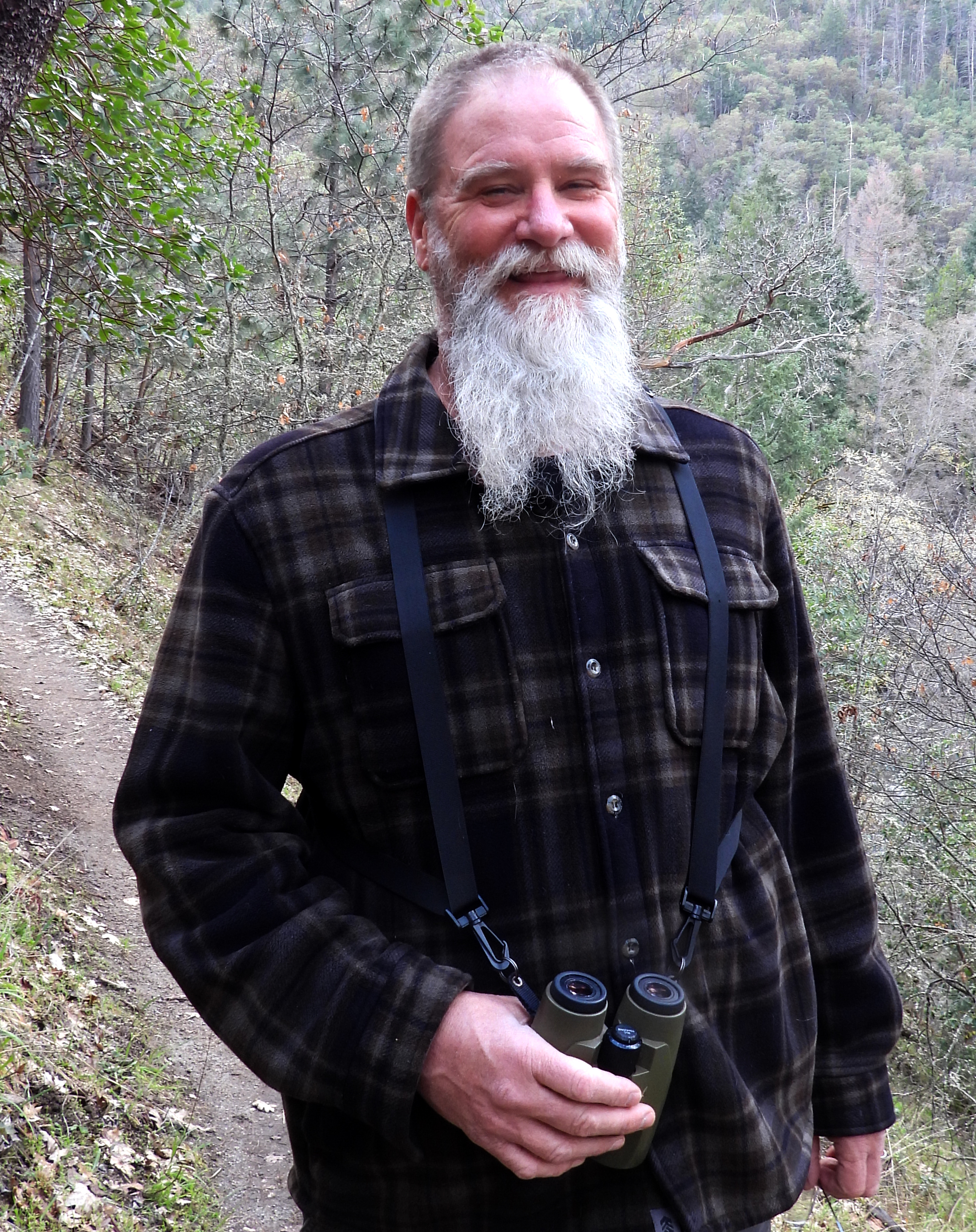
Jeff Miller is an amateur naturalist, professional conservationist, and passionate advocate for wildlife. Jeff is the founder of the nonprofit Alameda Creek Alliance and has served as its executive director since 1997, working to restore steelhead trout and salmon to Alameda Creek and protect the Bay Area’s largest local watershed. He’s a senior conservation advocate with the Center for Biological Diversity, spearheading biodiversity protection campaigns throughout the Bay Area and California, preparing endangered species listing petitions, writing press releases, and doing public outreach and organizing around wildlife protection issues. Over the last quarter century, he has been involved in conservation efforts for dozens of the most iconic imperiled wildlife species in the Bay Area, the most recent being securing state protections for burrowing owls. Jeff says that loving nature is as important as fighting for it and grieving ecological destruction. People tend to care more about animals and places that they have a direct experience with, so he wrote Bay Area Wildlife: An Irreverent Guide to try to connect readers with our regional fauna and inspire them to make a pilgrimage to witness the Bay Area’s spectacular natural phenomena.
BART will run Sunday service (8am-midnight) for New Year's Day 1/1/24

As we wrap up 2023, BART will be running Sunday service on Christmas Day, Monday, December 25, and 2024 New Year's Day, Monday, January 1.
BART service will be the following for the last week of 2023:
Christmas Eve, Sunday, December 24: standard Sunday service (8am-midnight)
Christmas Day, Monday, December 25: Sunday service (8am-midnight) to observe the holiday
New Year's Eve, Sunday, December 31: standard Sunday service (8am-midnight). BART will be providing 1am Extended Service for late night riders coming back from the New Year's Fireworks show in San Francisco or other celebrations.
New Year's Day, Monday, January 1: Sunday service (8am-midnight) to observe the holiday
Parking
Parking is always free after 3pm and on weekends. Parking will also be free on Christmas Day and New Year's Day. This applies to all BART stations except for Milpitas and Berryessa/North San Jose, as they are operated by VTA.
All other parking rules will be enforced.
For those travelling during the holidays and taking BART to the airport, you can purchase multi-day parking in advance through the BART official app. Check out our guide on how to pay for multi-day parking for airport riders.
Download the BART app to pay for parking and trip planning:
Join the fun! Click here to download BART-themed holiday cookie templates!
Holiday coloring sheets:
BART eliminates multi-million-dollar FY26 budget deficit through cuts and efficiencies
BART has eliminated what was projected to be a $35 million budget deficit for the next fiscal year through various cuts and strict cost control efficiencies. The upcoming Fiscal Year 2026 Preliminary Budget Memo, to be released at the end of the month, will now show a balanced budget for the fiscal year beginning July 1st, but structural deficits of $350 million to $400 million loom in following years unless long term, stable funding sources can be identified.
“We’re getting our budget in order to the extent that we can,” said BART Board President Mark Foley. “Closing a $35 million gap is no easy task. Now that we’ve overcome the first hurdle, we’ll focus on the bigger picture of restructuring BART’s funding model for long term sustainability.”
BART was able to close the projected $35 million dollar deficit through a combination of cost controls and revenue generation. Examples include:
Cost Controls
- A strategic hiring freeze while protecting safety and service quality
- Labor savings from reducing near term retiree healthcare costs
- Non-labor budget reductions across all departments
- Running shorter trains
- Locked-in low renewable electricity rates
- Implementation of Inspector General’s recommendations for efficiencies
Revenue Generation
- Installation of Next Generation Fare Gates to reduce fare evasion and increase ridership
- Maintaining inflation-based fare increases
- Offering new fare products like Clipper BayPass which is now revenue positive
- Improving transit coordination
- Growing ridership through station activations and events
- Negotiating new agreements for telecommunications revenues
Total operating expense growth in the FY26 budget is only 1% compared to inflation in the Bay Area at 2.7% over the past year and the size of workforce has been reduced from the current year due to the strategic hiring freeze. In fact, even before the recent cost cutting, BART has been able to keep its operating costs below the rate of inflation since 2019.
While BART is prioritizing high-quality and frequent service to attract more riders, overall, BART is running 100 fewer trains per week than before the pandemic.
BART is one of the most cost-efficient rail operators in the nation despite operating in a very high-cost region. By one measure, the cost per vehicle revenue hour, BART is significantly more efficient than similar systems like Washington, D.C.’s WMATA and Atlanta’s MARTA (Vehicle rail hour rates: BART - $283, MARTA $370, WMATA $466).
BART cannot close structural deficits with service cuts
As ridership continues to slowly grow, BART’s historical reliance on passenger fares to pay for operations, long seen as very effective, is outdated and no longer sustainable. New sources of funding are needed to avoid significant service cuts.
Even with belt-tightening, BART can’t cut its way out of the crisis without causing a transit death spiral. That is because rail has high fixed costs to maintain infrastructure and low marginal costs driven by changes in service. For example, when BART closed at 9pm and reduced frequencies during the height of the pandemic, it represented a 40% cut in service, but it only reduced operating costs by 12%. Even a 90% cut in service (9pm closure, one-hour frequencies, and running only three of the five BART lines) would close less than half of the FY27 $376 million deficit.
Next steps for the BART budget
The soon-to-be-released 2026 Preliminary Budget Memo will mark the beginning of the final stretch of BART’s budget activity for the year. A series of presentations at Board meetings will culminate in a Board of Directors vote in June to adopt a two-year budget for fiscal years 2026 and 2027.
BART rebuilding effort makes most of additional wrench time as trackway replacement begins in southern Alameda County
Initial work is underway for a large construction project in southern Alameda County. Crews will replace critical track components between the South Hayward and Union City BART stations as well as begin the preliminary work to build a new storage facility at the Hayward Maintenance Complex for hundreds of new
This May the 4th take a ride on a BART starship through a galaxy far, far away
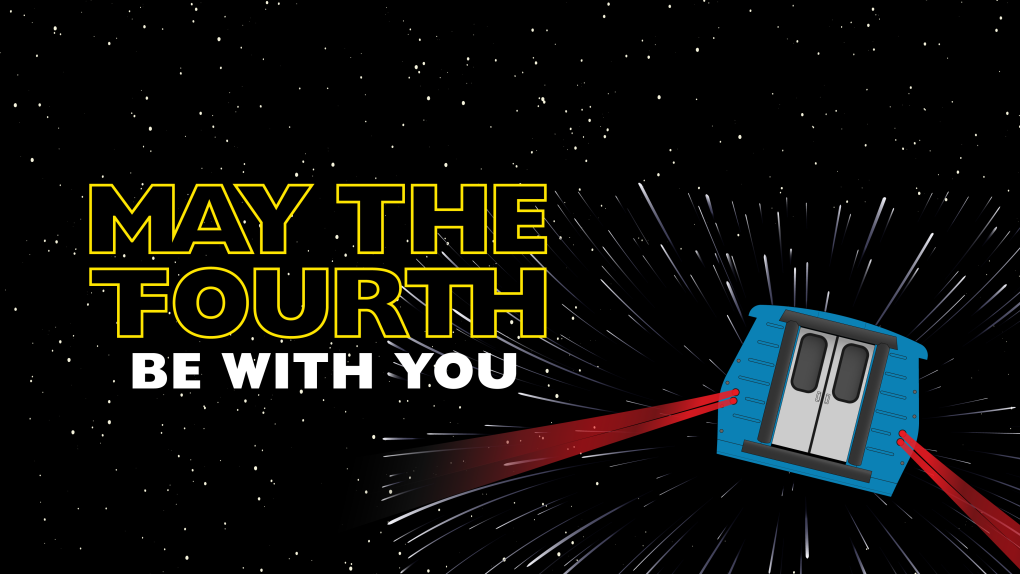
This May the Fourth, BART invites the public on an epic journey through a galaxy far, far away.
On Sunday, May 4, BART will transform a train into a special starship to set the scene for an epic 90-minute ride in celebration of May the Fourth. Bring friends or travel solo. Either way, you’ll leave with an alliance of like-minded pals.
Travelers should dress in apparel fitting for a May the Fourth celebration (please leave the blasters on your home planets). Prizes will be awarded to the best costumes. The admiral of our ship will look kindly on you for incorporating BART into your outfit. You can also expect live music, competitions, trivia, May the 4th decor, and plenty of surprises.
The voyage itinerary: We will depart MacArthur Spaceport at 4pm and make the jump into hyperspace to reach Pittsburg/Bay Point, a space station on the Outer Rim of our system. Our ship will then turn around and make its way back to MacArthur Spaceport with an estimated arrival time of 5:30pm. Pre-boarding will start at 3pm.
Our ship will make no stops for the duration of the 90-minute ride, so attendees should eat and use the restroom before departure. Artificial gravity will be provided for passenger comfort.
Space on our vehicle is limited, and reservations are required via Eventbrite. There is no cost to attend other than paying your BART fare.
When: Sunday, May 4, 4pm to 5:30pm
Check-in opens at 3pm. Arrive no later than 3:30pm.
Where: MacArthur Station
Why: May the 4th be with you
RSVP: Reserve your spot on Eventbrite – bartmaythefourth.eventbrite.com
The e-ticket you receive from Eventbrite is NOT your BART fare. Every participant must have a Clipper card. Make sure you have at least $7.10 (BART’s excursion fare) on the card.
BART is experimenting with hosting events on trains, including the sold-out Valentraine speed dating mixer in February, as a way to engage our community, foster connections, and encourage riding BART. Transit connects us to places, but can also connect us to each other. Learn more about fun stuff happening at BART at bart.gov/fun.
Take BART + Muni to Hardly Strictly at Golden Gate Park this weekend, 9/29-10/1
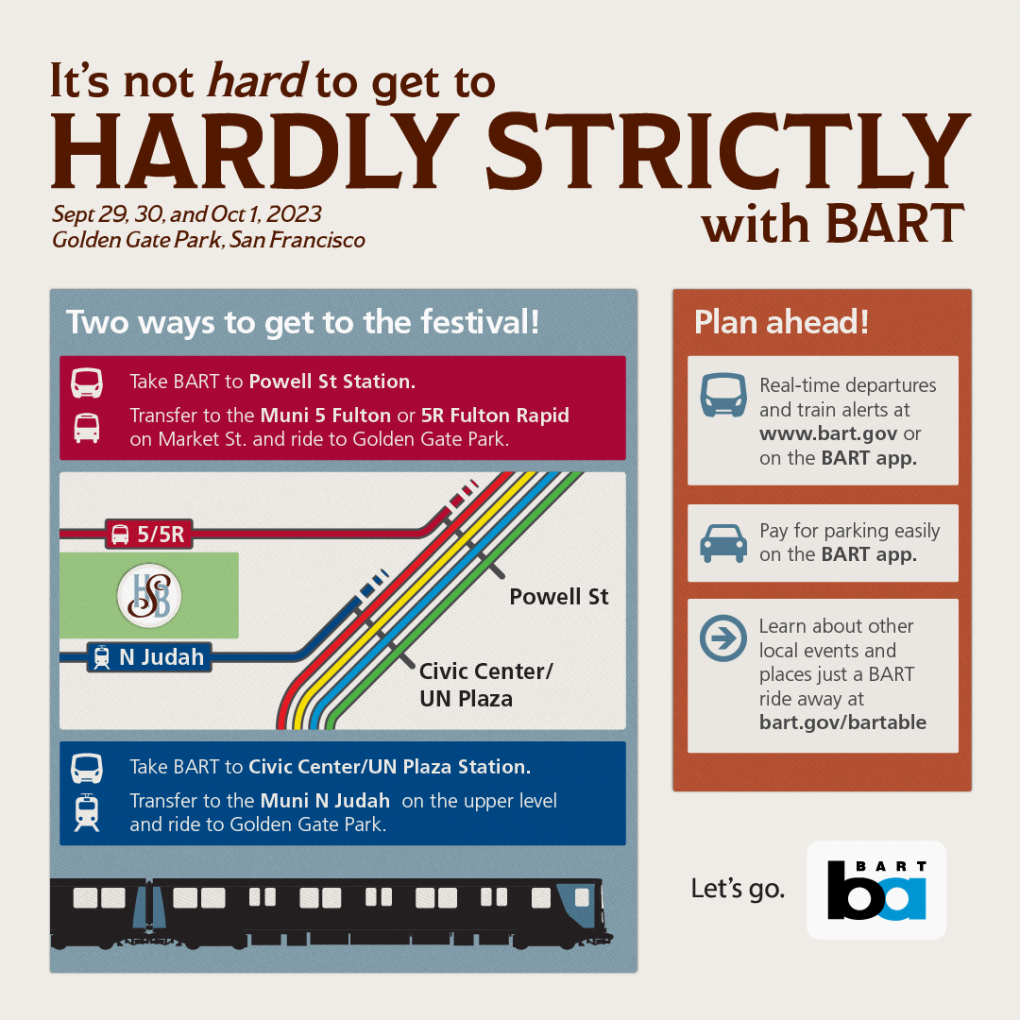
Heading to Hardly Strictly at Golden Gate Park this weekend? Public transit is your best bet there and back, and BART and Muni are here to help!
BART riders heading to Hardly Strictly from the East Bay can take a train to Powell Station. Transfer to a Muni 5 Fulton bus or 5R Fulton Rapid on Market Street and ride to Golden Park.
BART riders coming up from San Mateo County or San Francisco can take a train to Civic Center Station and transfer to a Muni N Judah train on the upper level of the station. The N Judah train will run near Golden Gate Park on Irving and Judah Streets.
Rider Tips
Parking is free at all BART stations except Milpitas and Berryessa (which are operated by VTA) on Saturday, September 30 and Sunday, October 1. Pay for parking easily on the BART app.
Before you leave home put a Clipper card on your cellphone through either Apple Pay or Google Pay. Clipper is waiving the $3 new-card fee for riders who add either of the mobile options. Please ensure you have sufficient funds for a round trip. Plan at the cost of your trip in advance.
Real-time departures and train alerts can be found at bart.gov/eta or on the BART app.
Hardly Strictly is only of many amazing events happening in the Bay Area this weekend! Learn more at BARTable This Weekend here!
Commitment to make BART the Bay Area's safest way to travel extends to infrastructure rebuilding plan
BART’s effort to rebuild its aging infrastructure is on track and is delivering results by improving the system’s reliability and overall safety. That’s the main conclusion from a new annual report issued by the independent panel of experts overseeing the Measure RR rebuilding program. The report will be presented to the BART Board of Directors at its meeting today, August 24.
The independent Bond Oversight Committee’s new Annual Report says through March 2023 $1.57 billion of Measure RR funds had been invested in rebuilding the backbone of BART. There are now 152 RR-supported projects that are in planning, design, construction, or have been completed. A total of 48 projects are complete, up from 36 when the committee issued its previous annual report in 2022.
46% of all anticipated Measure RR work has already been completed. The Bond Oversight Committee wrote the progress is ahead of projections made by BART in 2016 when Measure RR was put before BART District voters. The committee wrote it “believes BART is delivering rebuilding projects in a timely manner and that the work is improving the reliability and safety of the system.”
Significant accomplishments in the last year include:
*Substantial completion of the 34.5kV (kilovolt) traction power cable replacement work in downtown San Francisco.
*Completed trackway demolition and restoration for the Transbay Tube retrofit.
*Station modernization projects completed at Powell Street Station in downtown San Francisco and 19th Street Station in downtown Oakland.
*The number of service delays due to rail-related issues dropped from 217 in 2021 to 95 in 2022.
*Issuance of $700 million in climate-certified Green Bonds to ensure uninterrupted funding of RR projects.
Bond Oversight Committee members have unrestricted access to BART documents, hold quarterly public meetings to review the progress of the Measure RR rebuilding program, and are focused on ensuring BART is spending bond money in a manner consistent with what was promised to voters. You can learn more about the committee at bart.gov/bondoversight.
Measure RR is a $3.5 billion bond measure that was approved by voters in Alameda, Contra Costa, and San Francisco counties in 2016. The Bond Oversight Committee is comprised of seven members who represent a diversity of expertise. The organizations represented on the committee include the American Society of Civil Engineers, the Institute of Electrical and Electronic Engineers, the American Institute of Certified Public Accountants, the Association for Budgeting and Financial Management section of the American Society for Public Administration, the Project Management Institute, and the League of Women Voters.
BART offering special early service with limited stops for 2025 Bay to Breakers (May 18)
BART will provide four trains with limited stops before regular BART service begins for Bay to Breakers on Sunday, May 18, 2025. The special service will get race participants to Embarcadero around 7am.
The special early morning trains will pick up passengers for an Embarcadero arrival with limited service from the following stations: 16th St. Mission, Bay Fair, Daly City, El Cerrito del Norte, Dublin/Pleasanton, MacArthur, Millbrae, Pleasant Hill/City Center, and West Oakland.
These four trains will go out of service once they drop riders off at Embarcadero. Riders cannot board a train at Embarcadero.
Plan your trip using the BART Trip Planner.
Special Service Details
One train will leave Millbrae at 6:29am, Daly City at 6:42am, 16th St./Mission at 6:52am, and then arrive at Embarcadero at 6:57am. No other stops will be made along the line.
A second train will leave Pleasant Hill/Contra Costa Centre at 6:23am, MacArthur at 6:43am, West Oakland at 6:52am, and then arrive at Embarcadero at 6:58am. No other stops will be made along the line.
A third train will leave Dublin/Pleasanton at 6:17am, Bay Fair at 6:34am, West Oakland at 6:55am, and arrive at Embarcadero at 7:01am. No other stops will be made along the line.
A fourth train will leave El Cerrito del Norte at 6:33am, MacArthur at 6:48am, West Oakland at 6:55am, and arrive at Embarcadero at 7:02am. No other stops will be made along the line.
Regular systemwide BART service starts at around 8am.
Tips
BART parking is free on Sundays. People driving to BART to take the train should park at one of these stations being served: Pleasant Hill, El Cerrito del Norte, MacArthur, Bay Fair, West Oakland, Daly City, Dublin/Pleasanton, and Millbrae. 16th Street Mission does not have a BART parking lot.
BART has loaded these event trains as special service into BART Trip Planner. The service is demarcated with "-> Limited Stop to Embarcadero" in the planner.
Once on the platform, these four trains will be labelled as: “Limited Stop to Embarcadero.”
Load your Clipper card in advance with enough funds for your full trip.
If you don’t have a Clipper card, add one for free ($3 savings) to your phone’s wallet in advance and use Google Pay or Apple Pay.
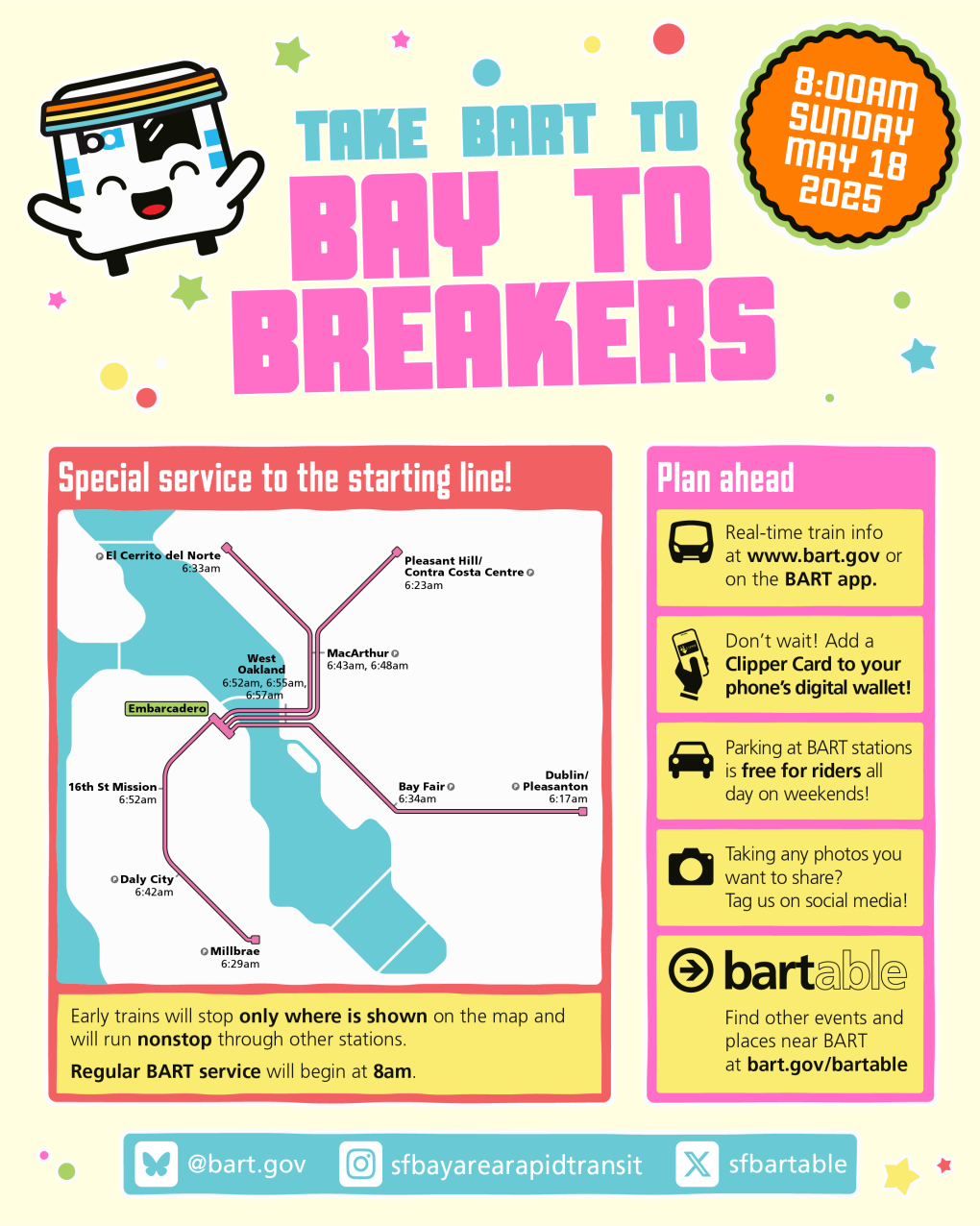
BART wants to hear from riders on proposed 2026 less-than-inflation fare increase
Update: The survey is now closed.
BART is seeking the public’s input on a proposed January 2026 less-than-inflation fare increase.
BART’s current funding model relies on passenger fares to run safe, clean, and reliable service and to help pay for key improvement projects. BART has a fare increase program that calls for small, regular, less-than-inflation increases every two years, with the next increase of 6.2% scheduled for January 1, 2026. For a short trip like Downtown Berkeley to 19th St./Oakland, the regular fare is estimated to increase by $0.15, and for a longer trip like Antioch to Montgomery, it’s estimated to increase by $0.55.
This proposed increase will help minimize the risk of service cuts while BART explores a long-term funding solution to restore financial stability, as some riders are taking fewer trips than before. Fares continue to be an important funding source to continue to meet the needs of riders who rely on BART.
Your feedback is important! Learn more and share your opinions by taking the survey online at bart.gov/faresurvey2025 or in-station at the locations listed below. The survey closes March 18. Respondents may choose to enter to win a $50 Clipper card at the end of the survey. It is available in multiple languages.
In-station survey locations:
Lake Merritt | Tuesday, March 4, 7am – 9:30am
Pittsburg/Bay Point | Thursday, March 6, 3pm – 6pm
Fruitvale | Monday, March 10, 7am – 9:30am
El Cerrito del Norte | Wednesday, March 12, 3pm – 6pm
Montgomery St | Thursday, March 13, 7am – 9:30am
BART offers the following fare discount programs:
Low-income adults earning 200% or less of the federal poverty level get 50% off through the regional Clipper START program.
Youth 5-18 years old get 50% off with a Youth Clipper card. 4 years and younger ride free.
Seniors 65 and over get 62.5% off with a Senior Clipper card.
The RTC Clipper card is a version of Clipper created for passengers under 65 with qualifying disabilities to provide 62.5% off.
BART offers a “High-value Discount.” Adult Clipper cards get a 6.25% discount on cash value rides by buying $48 worth of value for $45 or $64 worth of value for $60 when autoload is set up with your registered Clipper card.
Monthly “A” Adult Fast Pass + BART within San Francisco: Unlimited rides on all Muni vehicles and on BART within San Francisco (trips outside of these stations are charged full fare). Available for sale from the 17th of the prior month through the 16th of the month.
Students on a school-sponsored field trip for an educational purpose are eligible for a 62.5% discount fare when purchased in advance through Group Sales.
All discounts are set up in advance through Clipper: clippercard.com/discounts